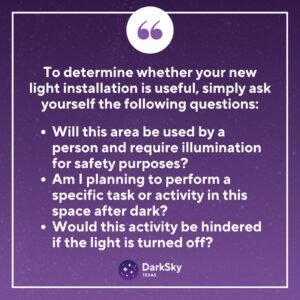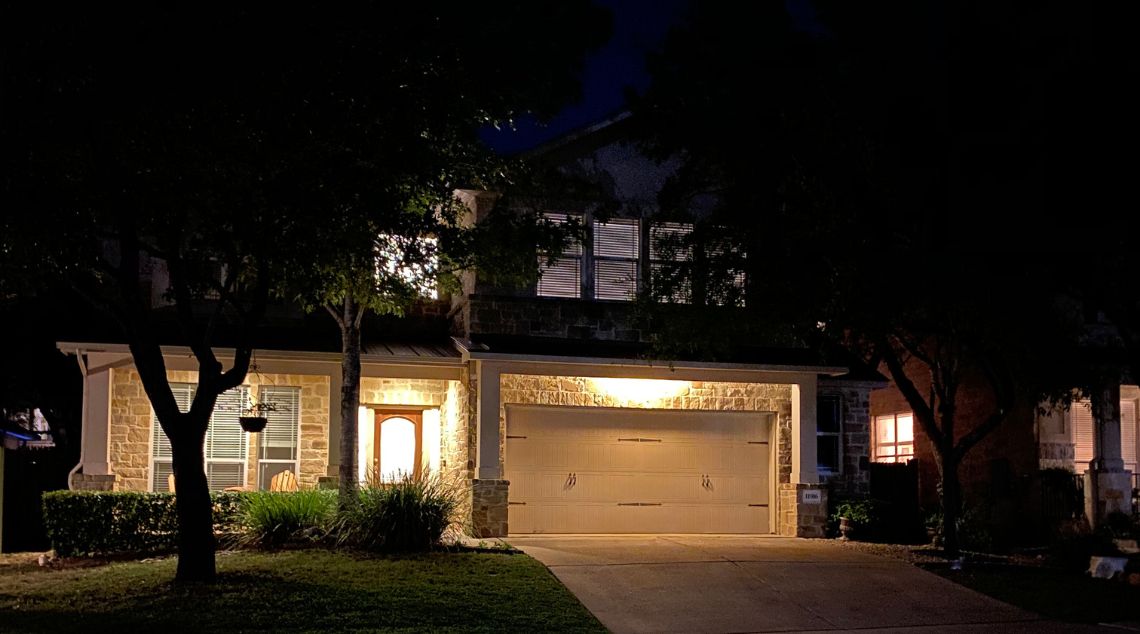Light pollution has emerged as an issue of concern around the world. At night, outdoor lights spread around the surrounding landscape, creating skyglow and disrupting natural cycles.
At DarkSky Texas, we want to promote the use of better outdoor lighting to preserve and restore natural darkness when appropriate and mitigate the negative impacts of light pollution everywhere by using artificial light at night responsibly.
This is much easier than it sounds – it revolves around five (5) key principles. Let’s look at the first one: keeping lights useful.
About the 5 Principles of Responsible Outdoor Lighting
The idea behind responsible outdoor lighting is to ensure outdoor lights have a specific function, do as little damage as possible to our health and the health of other living things, enhance our ability to see, and cause little impact to our shared view of the night sky.
All it takes to achieve this is to rethink our widespread use of outdoor lighting. Before turning lights on or off, we need to look around and consider whether these lights are useful.
Why do I Need This Light?
The first step to use outdoor lights responsibly is to question the use of each one.
The goal is simple: before we install or turn on any lights outdoors (or that may shine directly outdoors) we should determine why we need this specific light. Could reflectors or reflective paint serve the same purpose? Will a light colored driveway “pop” when your headlights hit it and not need additional illumination?

This helps us determine whether the light is truly necessary, prevent the waste of electricity (and the cost of leaving it on), and lower the amount of extra light that does not help us.
When we think of usefulness, we also allow ourselves a chance to think whether the light’s use will compensate for its potential impact on the area, the surrounding wildlife and their habitat.
To determine whether your light installation is useful, simply ask yourself the following questions:
- Will this area be used by a person and require illumination for safety purposes?
- Am I planning to perform a specific task or activity in this space after dark?
- Would this activity be hindered if the light is turned off?
Good Examples of Useful Outdoor Lights
By answering these questions, it quickly becomes evident that many of our outdoor lights are indeed useful and necessary – and yet, they can still be optimized as we will explore in future blogs about the other Principles of Responsible Outdoor Lighting.
Good examples of useful outdoor lights include:
- Lights that illuminate a walkway or the access to your home, as they provide you with safety when you get home.
- Street lights at busy intersections that are dimmed during low traffic time periods.
- Task lights on outdoor work or recreational areas, such as barbecue pits, walking paths, or sports fields.
But this goes beyond classifying a light as “a safety light” and automatically deems it useful. Let’s pretend we have a winding pathway from our parking spot to the house with three separate light sources. We definitely need some light to walk between the house and car safely after dark!
After we start playing with each light, however, we notice that one of these lights doesn’t increase visibility on our path – it just consumes energy needlessly. Upon further inspection, we realize that we can replace the other two lights with a single one, placed slightly to the side, where it doesn’t get blocked by a nearby tree. That’s a win-win for our electric bill and for the amount of light pollution we create.
What Lights are NOT useful?
Many times, landscapers and builders simply add lights to their plans because they feel the property owner might want a specific space lit or they are in the habit of adding lots of lights – even if nobody will be around to enjoy its effects. Such examples include:
- Continuously lit decorative lights on trees or bushes
- Bright flood or area lights illuminating an area not in use by anyone
- Uplighting on buildings or monuments or billboards which could have been gently illuminated from above and/or turned off for sensitive wildlife
- Excessive lighting where it may interfere with seeing well, stargazing or natural nighttime environments
Want to Help Fight Light Pollution Around Texas?
By using light wisely, we can see better, protect wildlife, conserve energy, and preserve our heritage of the night sky. Support our efforts to help create a brighter, more sustainable future for all. Click here to learn of the many ways you can support DarkSky Texas– by donating, becoming a member, or volunteering!


